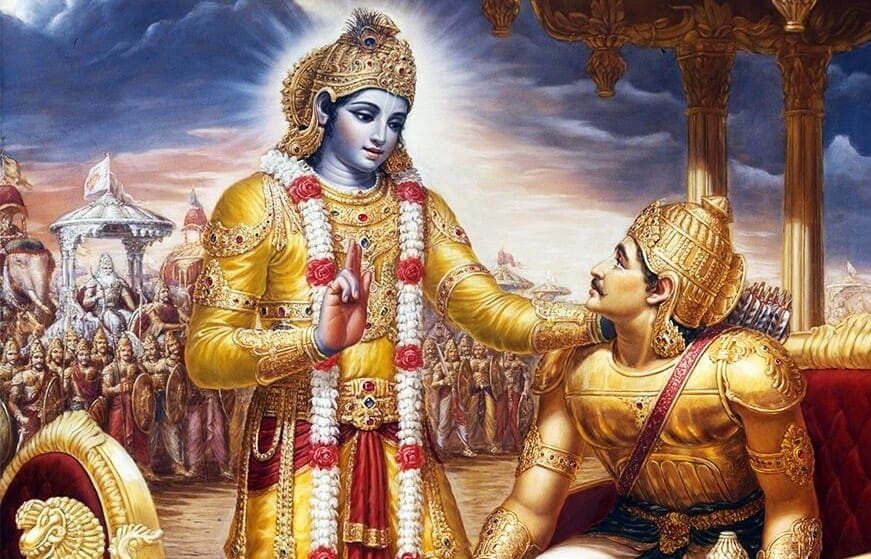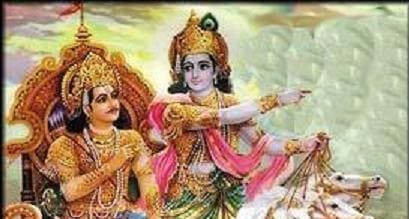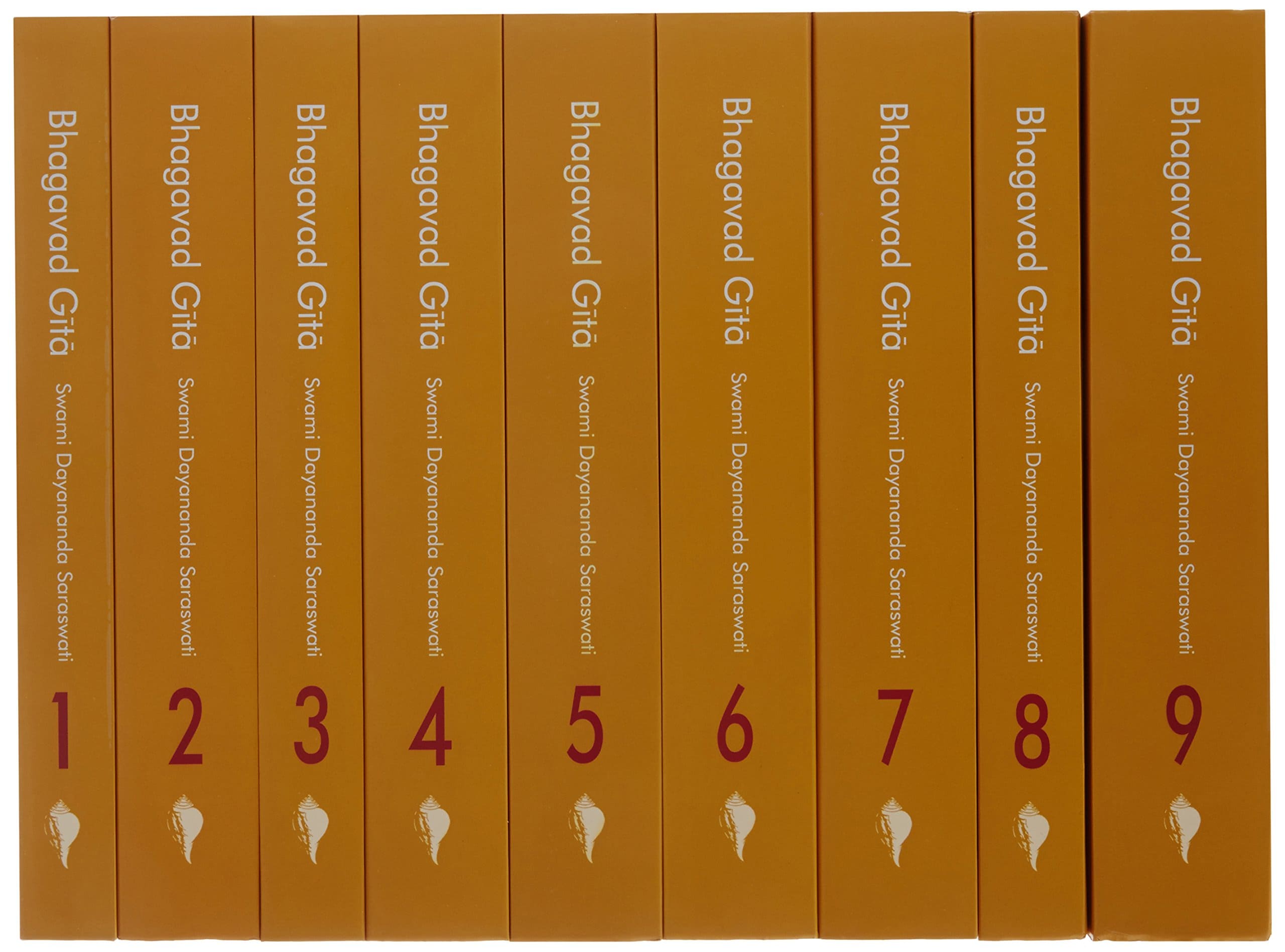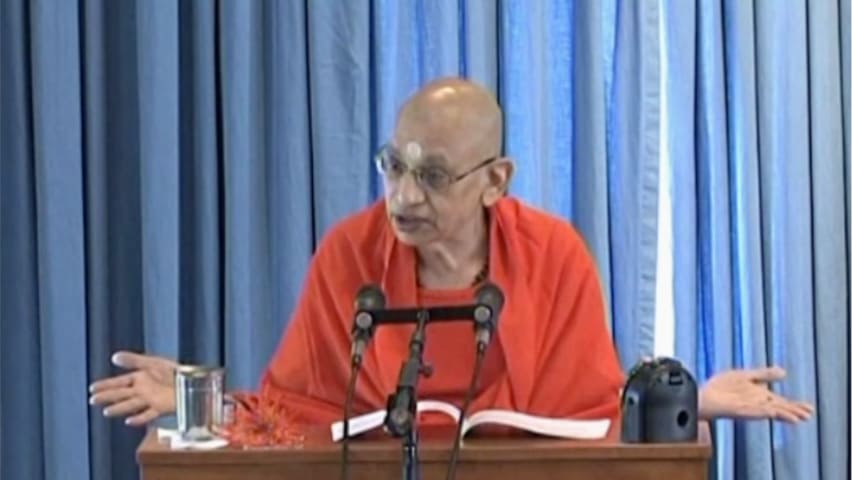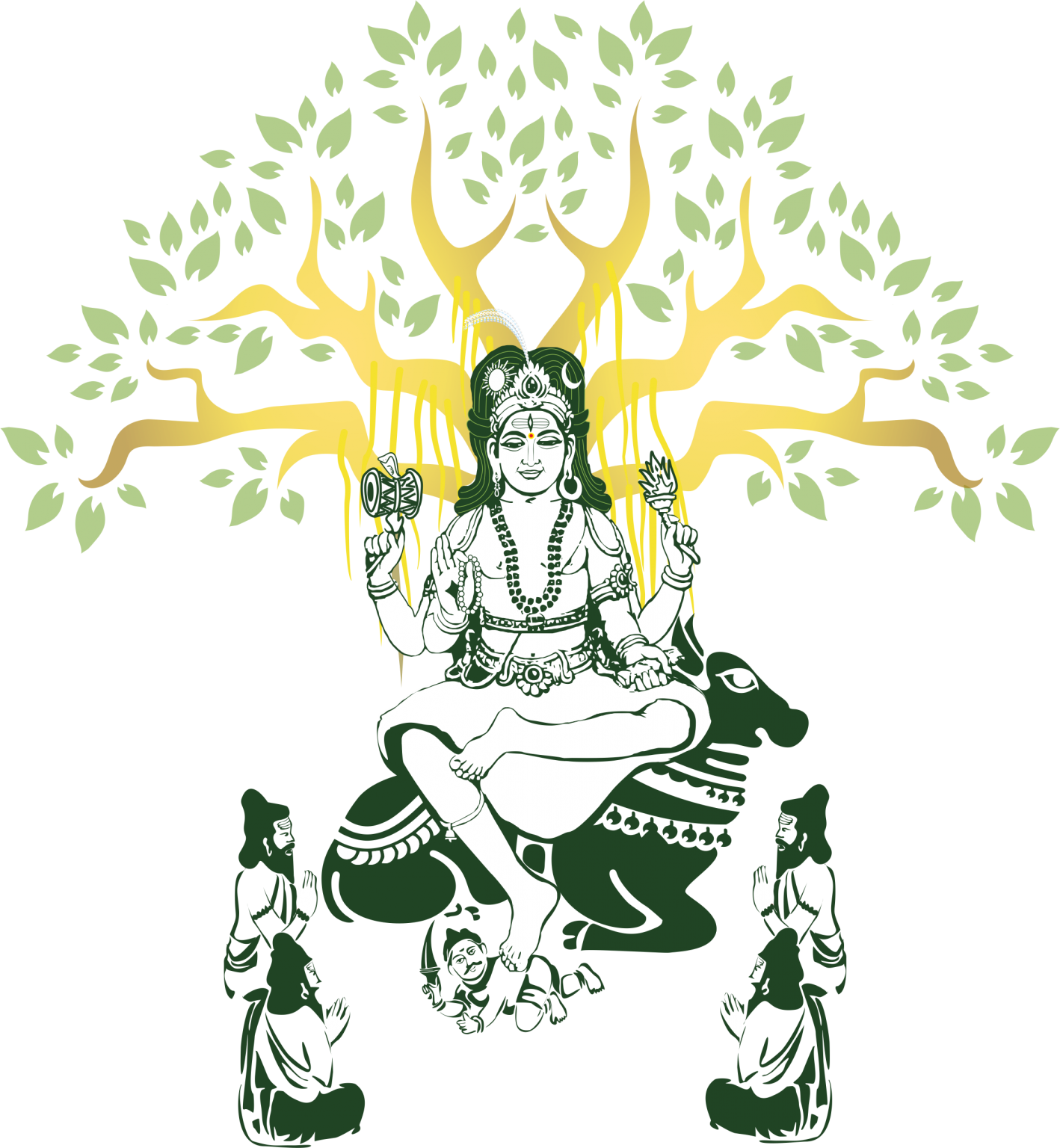Bhagavad gītā Home Study: Chapter 7, Verses 4-5
Published in the 14th Anniversary Souvenir of the Arsha Vidya Gurukulam, 2000.
Lord Kṛṣṇa Reveals Himself As The Two-Fold Cause Of Creation
There are two prakṛtis. The word prakṛti means that which has the essential capacity to create. Prakṛti is also called kāraṇa, the cause. Kṛṣṇa says, “I have two prakṛtis, one is svarūpa-prakṛti, and the other is svabhāva-prakṛti.
Svarūpa-Prakṛti
One prakṛti is the cause for everything; the truth of everything, without which nothing is possible. This is called svarūpa or para-prakṛti. Svarūpa, as I have told you, is that which makes something what it is. For example, ice is cold and that coldness is its svarūpa. You cannot remove it and still have ice. And here similarly, ātmā cannot give up its nature, consciousness.
Consciousness is the svarūpa of ātmā; it is not a quality, an attribute of ātmā. There is no other person there for whom consciousness is an attribute. In fact that ‘I’ itself is in the form of a conscious being alone. Therefore, consciousness is the svarūpa of the ātmā. It is not an attribute of ātmā. And if consciousness is the svarūpa of ātmā, there are a few other facts we recognise about consciousness. It is satya; it is ananta, etc. From the various standpoints of our knowledge about the world, we say this consciousness is satya. That means everything else is not satya; this consciousness alone is satya. It is not that we are refusing to accept another satya. There is only one satya; this is ātmā. Generally, we think that what exists is satya. Here, we take that existence itself to consciousness. And because it is satya it is ananta, without limit. Satyaṃ jñānam anantaṃ brahma is ātmā. This is the prakṛti of everything. Here you must understand prakṛti as the cause of everything, sarvasya kāraṇam. Therefore, it is called the svarūpa-prakṛti.
Svabhāva-Prakṛti
Then there is another prakṛti which we call svabhāva-prakṛti or apara-prakṛti consisting of the five elements, both subtle and gross. It is divided into cause, kāraṇa, and effect, kārya. Because the effect, kārya is not separate from the cause, the kārya is also called prakṛti. Therefore we have the expression kārya-prakṛti. A physical body consisting of the five elements is also kārya-prakṛti as are the sense organs, the mind, and prāṇas. In other words, anything created, anything put together is a kārya-prakṛti. Kārya here is anything that is produced, anything put together. If we look at this prakṛti, this is also called māyā, avyakta, or mūla- prakṛti. This prakṛti is the upādhi from which the whole creation has come. And the upādhi is for paramātmā. Therefore, sat-cit-ānanda-ātmā becomes the cause for this entire world and the māyā is the svabhāva, cause.
Now where does this māyā have its being? Is it in the product or in Brahman? It is in Brahman. It cannot be elsewhere because the product itself is mithyā. So this māyā has its being in Brahman — brahma-āśrayā hi māyā. Brahman is satyaṃ jñānam anantam which is ātmā. That Brahman is the āśrayā for māyā and its products.
In this chapter, Lord Kṛṣṇa first talks about kārya or apara-prakṛti. Then he says there is another prakṛti, para-prakṛti that is the real cause , without which there cannot be any creation. The real cause means that which supplies the existence, and without which there is no creation possible. He says, ‘The truth of the whole creation, the real cause, is my svarūpa. And you are that svarūpa. That is the real prakṛti and therefore what you have to know is that real prakṛti which is Īśvara in reality. You have to know these two types of prakṛtis, and know that the svarūpa or para-prakṛti without which there is no creation at all, is yourself. I am you. In fact, I am the cause of everything and I am you.’ This means you are the cause of everything as satyaṃ jñānam anantam brahma.
Then the next question you’ll ask, will be, ‘How can I be the cause? How can I be Īśvara?’ And I will say that if you say you are not, you are not. If you say you are a jīva, you’ll continue to be jīva. You’ll never become Īśvara. An individual is an individual; he is not going to become Īśvara. And if you say, ‘I am Īśvara,’ then the problem is, where is this ‘I’ placed? That has to be understood. Therefore, in the verses that follow, Kṛṣṇa unfolds the two types of prakṛti to prove that Īśvara is everything and his svarūpa is you.
Earth, water, fire, air, space, mind, intellect and indeed the sense of doership — thus this prakṛti of mine is divided in an eightfold way.
The two-fold prakṛti, mentioned in the introduction to this chapter is the cause of this entire world. In this chapter they are called parā and aparā prakṛtis. Para- prakṛti is the ultimate cause without which there is no effect possible. Then the immediate cause is called apara-prakṛti, in other words, māyā and all that is immediately born of māyā. Because subtle elements are the causes for the gross elements which come later, they are mentioned first here as apara-prakṛti.
Iyam, this entire world, is my prakṛti, me prakṛti, divided in an eight-fold way, aṣṭadhā bhinnā. Aṣṭa is eight; aṣṭadhā is eight-fold. Here he tells us what are the eight-fold subtle constituents beginning with the earth, bhūmi, as a tanmātra, a subtle element. Tanmātra means tat mātra, that alone is there. In grossification, each element combines with the other four elements. But in the subtle form, such a combination has not taken place so they are called tanmātras. Each element has its own guṇa which we experience sensorily. For instance the earth has its own guṇa, smell, and so the smell tanmātra is what is referred to here as bhūmi. Similarly, the taste, rasa-tanmātra is water, āpaḥ; form tanmātra is fire, agni; touch tanmātra is air, vāyu, sound tanmātra is space, kham.
Prakriyā— A Teaching Model
Using a particular model like this to teach the nature of the creation is using a sṛṣṭi-prakriyā. A prakriyā is a particular discussion which is useful for understanding the vision. The intention of using any prakriyā is only to point out that there is nothing other than paraṃ brahma. So the intention of a prakriyā dealing with creation, sṛṣṭi, is not to reveal the creation but to establish that there is nothing other than Brahman.
Like the sṛṣṭi-prakriyā, there are other prakriyās such as avasthā-traya-prakriyā, an analysis of the three states of experience; pañca-koṣa-prakriyā, an analysis of the five levels of one’s experience of oneself; and dṛk-dṛśya-prakriyā, subject-object analysis to distinguish ātmā from anātmā and later prove that anātmā is not separate from ātmā because it is mithyā. The five elemental model of this universe is a part of the creation or cause-effect prakriyā sṛṣṭi-prakriyā or kāraṇa-kārya-prakriyā. We find this sṛṣṭi-prakriyā in many Upaniṣads.
Sṛṣṭi-Prakriyā — Analysis Of Creation In Chāndogyopaniṣad
In the sixth chapter of Chāndogyopaniṣad, the sage Uddālaka tells his son, Śvetaketu, that before the creation of this world there was only one thing. It was sat, existence, advitīya, non-dual, and there was nothing except that. Advitīya because there was no other sat-vastu like itself nor was there any vastu unlike itself and in itself there were no parts. It was one non-dual. Since there was no difference within itself nor was there any differentiating factor, it is a part-less whole.
Mentioning this sat-vastu in his opening statement, Uddālaka talks about the creation of the elemental world from this sat-vastu. He mentions only three elements, the elements which have form, pañca-bhūtas — agni – fire, āpaḥ – water, and pṛthivī – earth. The two form-free elements, ākāśa and vāyu, are not mentioned. The purpose was only to show that having come from sat-vastu, they don’t have a being of their own apart from the sat-vastu. In fact, the creation is non-separate from its cause like the pot is non-separate from the clay.
Finally he says, ‘Oh! Śvetaketu, that sat-vastu is ātmā.’ Everything else is created. The body is created; the mind is created; the senses are created. But what is not created is ātmā. And that is sat-vastu which was even before creation. Even now it is sat-vastu, uncreated ātmā. And therefore, tat tvam asi — ‘you are that.’ From nine standpoints he points out that the vastu is always the same. Before and after the creation it is the same; that ātma-vastu did not undergo any change. Now, even though it is upādāna-kāraṇa, material cause, it is upādāna-kāraṇa in terms of māyā. Without undergoing any change itself, the sat-vastu manifests in the form of this world with the śakti of māyā. And the creation, being purely nāma-rūpa, is mithyā. The truth of the creation, the sat-vastu is you, ātmā. So to create this vision that you are the sat-vastu and the world is non-separate from the sat-vastu, we have a sṛṣṭi-prakriyā.
Avasthātraya-Prakriyā— Analysis Of The Three States Of Experience In Māṇḍūkyopaniṣad
Similarly, we find the avasthā-traya-prakriyā in Māṇḍūkyopaniṣad. The first verse says all that is, all that was, and all that will be is but oṃ-kāra. Each individual letter of om was made to stand for something. O-kāra represents waking, the waker and the waking world, u-kāra, the dreamer and the dream world, ma-kāra the sleeper and the sleep experience. All three of them are shown to be non-separate from the same ātmā. which
itself is neither the waker consciousness, nor is it dreamer consciousness, or sleeper consciousness. And it is not the consciousness in between waking and dream consciousness nor is it all consciousness, or unconsciousness. Naturally what remains after negating all this is consciousness as such. All other things qualify that consciousness. And this is the nature of yourself; that is called caturtha. It is neither waker, dreamer, nor sleeper. Therefore, caturthaṃ manyante sa ātmā sa vijñeyaḥ (Māṇḍūkyopaniṣad, 7) — what is looked upon as caturtha, the fourth, that is the real ātmā. It is all three and is itself independent of all three. It doesn’t undergo any change and is the ātmā in all three states. That has got to be known. This is the avasthā-traya-prakriyā which is discussed in the Māṇḍūkyopaniṣad, and in other Upaniṣads as well.
Pañcakoṣa-Prakriyā- Analysis Of The Five Levels Of Experience Of Oneself In Taittirīyopaniṣad
In the Taittirīyopaniṣad there is a pañacakoṣa-prakriyā. It begins with the physical body, anna-rasa-maya, which is like a cover, koṣa, because everyone mistakes it for ātmā. It is born out of the essence of the food that is eaten, anna-rasa. The assimilated form of food is anna-rasa-maya. The affix mayat means modification, vikāra, so anna-rasa-maya is a modification of the essence of food. We generally conclude that the body is ātmā.Therefore, śruti points out that there is another ātmā which is more interior, subtler. This is prāṇa. The śruti then describes the physiological function, prāṇa-maya. If you think this is ātmā, śruti leads you further to another ātmā, mano-maya and from mano-maya to vijñāna-maya, the doer, then from vijñāna-maya to ānandamaya.
Sukha, happiness is also experienced in different degrees because of shades of difference in vṛttis. So within that ānandamaya, priya is the first stage of happiness. Something that is pleasing or desirable to you is sighted, that is priya. Then what is desired is possessed by you; this is moda. The third stage in which it is experienced by you is called pramoda. These are degrees of ānanda, all of which are particular modes of thought, vṛtti-viśeṣas. But in all three, priya, moda, and pramoda, what is present is ānanda. And that ānanda is myself. That is Brahman.
Tanmātra Prakriyā— A Type Of Sṛṣṭi-Prakriyā
Here, Kṛṣṇa uses the tanmātra-prakriyā. Tanmātra, as we have seen, means the five subtle elements. These five subtle elements undergo a process of grossification whereby each element shares half of itself with the other four. Therefore, each gross element is five-fold and has one eighth of each of the other elements. For example, sthūla-ākāśa is one half sūkṣma ākāśa, one eighth sūkṣma-vāyu, one eighth sūkṣma-agni, one eighth sūkṣma-āpaḥ and one eighth sūkṣma-pṛthivī. Thus every gross element is five-fold and because it is formed of these fivefold elements; the world itself is called prapañca, five-fold, in Sanskrit. This prapañca was originally tanmātra. Only that alone, tat-mātra, was there. In other words, in ākāśa, ākāśa alone was there; in vāyu, vāyu alone; in agni, agni alone; in āpaḥ, āpaḥ alone; in pṛthivī, pṛthivī alone. In the sūkṣma form they don’t have these five fold combinations so they are called tanmātras.
These tanmātras, ākāśa, vāyu, agni, āpa, pṛthivī, have been listed in the reverse order in this verse. If they are listed as space, air, fire, water, earth, it is the order of creation, sṛṣṭi-krama. But because Arjuna is now looking at the already created, the sṛṣṭi that is there, the elements are listed beginning with bhūmi. These five elements have many synonyms. Here pṛthivī, the earth, is called bhūmi, agni, the fire, is called anala and ākāśa is called kham. All five of these elements are to be understood here as subtle, i.e., sūkṣma because they are mentioned as the cause here. Then manas, buddhi, ahaṅkāra are also added to these elements. Since they are all products, they have to be looked at from the causal level. The five subtle elements with these three are the eightfold cause for this entire jagat.
The cause of the mind is ahaṅkāra. So manas stands for ahaṅkāra; buddhi is mahat-tattva and ahaṅkāra in the verse stands for the unmanifest, avyakta. Kṛṣṇa wants to point out all the causes and he arranges them in the order that is generally discussed elsewhere. Ahaṅkāra is mentioned last because avyakta, the unmanifest is the primary cause with reference to the creation.
It is upādāna-kāraṇa, the material cause for the creation. While Brahman does not undergo any change, the upādāna-kāraṇa undergoes all the change and is therefore looked at as pariṇāmī, that which undergoes modification.
Then there is a new problem. If you say Brahman is the cause, then Brahman must undergo some change in order to become the creation. Yes. As pariṇāmī-kāraṇa it does and that change takes place only in the māyā-upādhi. Only from the standpoint of māyā is it pariṇāmī-kāraṇa; from the standpoint of itself it is vivarta-upādāna-kāraṇa. It doesn’t undergo any change. The material cause itself is analysed as a cause that undergoes change and as that which doesn’t undergo any change. Satyaṃ jñānam anantaṃ brahma cannot undergo change. The avyakta, the māyā alone undergoes changes.
Lord Kṛṣṇa says that this māyā-śakti itself has become this eight-fold cause for the entire creation. So in an eightfold way this māyā-śakti, which is non-separate from me, is the cause for everything. Māyā is not a parallel reality; it is the Lord’s own śakti. And in an eightfold way, it becomes the prakṛti for the creation. This is called apara-prakṛti. The other prakṛti,
Oh! Mighty armed, (Arjuna), this is (my) lower (prakṛti). Whereas, please understand the one other than this, my higher prakṛti (my very nature), which is the essential nature of the individual, by which this world is sustained.
What Has Been Described So Far Is Aparā (Svabhāva)-Prakṛti
lyam, this apara-prakṛti is the prakṛti which is the cause for everything created. This should not be taken as myself. It is apara-prakṛti, a lower prakṛti. Therefore, Śaṅkara says, it is indeed, anarthaka, something that brings about the undesirable. This is the prakṛti that creates all the problems. It is the one that causes you duḥkha by giving you a jīva-śarīra, etc. Out of this prakṛti, your body, mind, and senses are produced. And because of this alone, you have all the duḥkha associated with them in the form of all their limitations. All these are caused by this apara-prakṛti. Its very form is the bondage of saṃsāra. For this reason it is the lower prakṛti.
My Real Nature — Para-Prakṛti
Then what is the higher prakṛti? Tu, whereas, itaḥ anyām – other than this, me parāṃ prakṛtiṃ viddhi – please understand my higher prakṛti. Other than this, please understand the svarūpa of myself, my very nature as the parā prakṛti. This parā-prakṛti, Śaṅkara says, is viśuddha, pure, not touched by anything. Parā means utkṛṣṭā the most exalted prakṛti. With reference to the other one, it is utkṛṣṭā, because if you know this prakṛti, you are liberated. The other prakṛti will bind you.
My Real Nature Is You
Here, Kṛṣṇa, speaking as Īśvara says please understand my real nature and that is jīvabhūta – in the form of the jīva. And that is you. In this prakṛti, ātmā always remains the same. That ātmā, sat-cit-ātmā is the kṣetrajña, the one who knows the entire kṣetra. The kṣetra is the mind, intellect, doership, memory, body, senses, sensory world, etc. The ātmā that illumines all of them is called kṣetrajña. That is the real meaning of the word jīva, the one who is in every kṣetra. Later Kṛṣṇa is going to say that in every body, mind, sense complex, sarva-kṣetreṣu, the one who remains there is ātmā, kṣetrajña (Bhagavad Gītā, 13.2).
